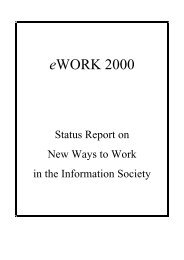Proceedings of 8th European Assembly on telework (Telework2001)
Proceedings of 8th European Assembly on telework (Telework2001)
Proceedings of 8th European Assembly on telework (Telework2001)
Create successful ePaper yourself
Turn your PDF publications into a flip-book with our unique Google optimized e-Paper software.
84With distributed workforces <strong>on</strong>ly accessing buildings periodically the role <str<strong>on</strong>g>of</str<strong>on</strong>g> buildings is shiftingdramatically. Work can take place anywhere so why should some-<strong>on</strong>e come to the <str<strong>on</strong>g>of</str<strong>on</strong>g>fice? The<str<strong>on</strong>g>of</str<strong>on</strong>g>fice is seen as an opportunity to express the culture and reinforce the values and beliefs <str<strong>on</strong>g>of</str<strong>on</strong>g> anorganisati<strong>on</strong>. The physical work envir<strong>on</strong>ment and the opportunities it provides for interacti<strong>on</strong> andcollaborati<strong>on</strong> aids knowledge transfer and communicati<strong>on</strong> and will form the infrastructure forlearning organisati<strong>on</strong>s.The distributed workplace model developed by DEGW also tries to incorporate the increasingc<strong>on</strong>gruence between physical and virtual work envir<strong>on</strong>ments, acknowledging the impact thatinformati<strong>on</strong> and communicati<strong>on</strong>s technologies have had <strong>on</strong> the work process <str<strong>on</strong>g>of</str<strong>on</strong>g> most individualsand organisati<strong>on</strong>s.The model also examines the c<strong>on</strong>tinuum between public and private space and produce novelsoluti<strong>on</strong>s to their integrati<strong>on</strong> into work places. The workplace is divided into three c<strong>on</strong>ceptualcategories according to the degree <str<strong>on</strong>g>of</str<strong>on</strong>g> privacy and accessibility they <str<strong>on</strong>g>of</str<strong>on</strong>g>fer. The three categories <str<strong>on</strong>g>of</str<strong>on</strong>g>place used in the model are “public”, “privileged” and “private”.Each <str<strong>on</strong>g>of</str<strong>on</strong>g> these ‘places’ is composed <str<strong>on</strong>g>of</str<strong>on</strong>g> a number <str<strong>on</strong>g>of</str<strong>on</strong>g> different types <str<strong>on</strong>g>of</str<strong>on</strong>g> work settings, the relativeproporti<strong>on</strong> <str<strong>on</strong>g>of</str<strong>on</strong>g> each forming the character <str<strong>on</strong>g>of</str<strong>on</strong>g> the space. Public space is predominately suited forinformal interacti<strong>on</strong> and touchdown working for relatively short periods <str<strong>on</strong>g>of</str<strong>on</strong>g> time. Privileged spacesupports collaborative project team and meeting spaces as well as providing space for c<strong>on</strong>centratedindividual work. Private space also c<strong>on</strong>tains both individual and collaborative work settingsbut with a greater emphasis <strong>on</strong> privacy and c<strong>on</strong>fidentiality, with defined space boundaries andsecurity.Figure 1:SANE Space Envir<strong>on</strong>ment Model








